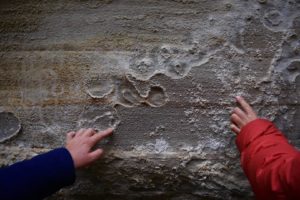 As we paddled down the Upper River Breaks National Monument, I was constantly reminded of the Corps of Discovery’s observations recorded by Lewis and Clark regarding the presumably untouched wilderness. These documented observations are found plastered on papers, posters, and plaques along the Upper Missouri river bottom, in “baseline of wilderness statements” in our course readings, and embedded in the minds of Americans across the country.
As we paddled down the Upper River Breaks National Monument, I was constantly reminded of the Corps of Discovery’s observations recorded by Lewis and Clark regarding the presumably untouched wilderness. These documented observations are found plastered on papers, posters, and plaques along the Upper Missouri river bottom, in “baseline of wilderness statements” in our course readings, and embedded in the minds of Americans across the country.
Quite frankly, Lewis and Clark’s Eurocentric observations of presumably pristine land untouched by humanity encapsulated the ignorance of a young America. Lewis and Clark’s observations of wilderness are used by many nature advocates, including the Upper Missouri River Breaks (UMRB) National Monument. Selecting the conditions of this landscape during this time period as a baseline for wilderness is as arbitrary as the reason my mom named me Nick — simply because she liked it. Lucky enough for me, that arbitrary decision my mother made two decades ago results in the occasional involuntary head turn because someone called out to a Nick that wasn’t me. Unfortunately for conservation and preservation agencies, they are plagued by the task of bringing to life the ecosystems in transition poorly described by Lewis and Clark over two centuries ago.
They are tasked with creating an illusion of the past.
Unknowingly, as we took a short walk from camp to the white sandstone rock faces that overlooked Lewis and Clark’s campsite at Eagle Creek, I was soon reminded of Lewis and Clark’s follies in describing an “untouched” wilderness. Our destination was at the mouth of a stunning coulee, now inhabited by grazing cattle, a murmuring creek, and I suppose occasional pesky paddlers like myself. As we approached the rock face, we couldn’t seem to resist reaching out toward the crumbling sandstone in its magnificent existence.
Our eyes wandered aimlessly around the rock face trying to read whatever lessons had been authored into its surface by eons of wind and rain. We also discovered a scruffy etching dating back to the early twentieth century, a period that was one of the last gasps for homesteaders in the area. One of our instructors, Steve, brought to the group’s attention another man-made alteration to the rock. The horse’s neck stretched outward with a long yet familiar face, fixing its gaze permanently towards the Missouri River. Its body was long with a slightly downward-curving back held up with four slender legs, a sagging abdomen, and a distinctly long tail, flowing thickly in frozen eddies from the petroglyph’s rump. The Native American’s petroglyph and the homesteader’s etching stand as reminders of European influence on the American Landscape.
The horse petroglyph could date back to roughly the late 17th or early 18th century, according to our instructor’s educated guess. We often think of the horse as a staple in the wild Americas, yet its existence here can be accredited to the Spanish explorers’ presence in the Southwest. They established small herds that gave birth to the robust herds of legend and the heavy grazing that would change landscapes across America, and the Natives’ lives that inhabited the area (Manning 19). The Great Plains Natives found tremendous value in the horse for its ability to run and pull loads, thus making the permanent residence of horses on the plains possible (Manning 19). The significance of the horse’s presence on the plains is that of a new-found way of life for the Natives, and in turn the creation of a disruptive ecological wake in their path.
During the early 1800’s, the progression of permanent residence on the plains continued largely in credit to the horse. And yet, explorers like Lewis and Clark wrote of an “unexplored” wilderness that they took to be pristine while in fact the land had been heavily impacted by European influence (mostly by trappers, wolfers, and frontiersmen) and Spanish horses established in the area for over a century.
In his book Rewilding the West, Richard Manning defends the mission of re-establishing a fully functioning prairie ecosystem as pursued by the American Prairie Reserve (APR), a private conservation project. As part of his argument, Manning suggests “the tales (told by Lewis and Clark) of abundance were also an illusion.” (18) As I read countless essays, excerpts, and posters quoting Lewis and Clark’s “observations” of the pristine West, I cannot help but feel that these accounts stand as a flashing indicator of America’s collective consciousness of their baseline for wilderness: a collective conscious that continues to steer environmental action towards goals set by a false sense of wilderness.
These ecosystems the Corps of Discovery thought they were discovering were already in the early stages of transition due to the relatively new Northern Great Plains Natives’ permanent residency in the area, and other European influences, but it was recorded as untouched wilderness. Regarding the mission of the American Prairie Reserve, the question must be asked: what kind of baseline of wilderness standards for preservation and conservation projects is APR striving for? Returning an ecosystem to such a condition is like trying to stop bobsled on an icy slope without brakes. When will we begin to listen to our currently oppressed ecosystems’ native species gasping for breath in the outskirts of crop fields and along the banks of dammed rivers, and the stump-like stems of overgrazed pasture? It is difficult to observe the present and plan for the future by looking through broken rose-colored glasses at the past for answers.